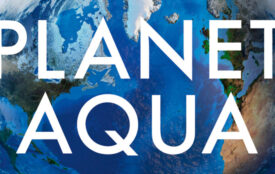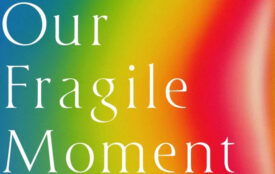A year of living optimistically
Bad news might sell books and turn science authors into global celebrities, but it isn’t particularly good at changing minds, motivating people or inspiring hope.
It certainly isn’t convincing our species to give up our game of ecological Russian roulette. Review by Evan Osenton
Chris Turner would know: In the mid-1990s, he took a summer job for Greenpeace as a door-to-door canvasser in Kingston, Ont. His specialty – indeed, he notes, most environmental groups’ specialties then and now – was bad news. Doom. Gloom. Lurid descriptions of bleached coral and starving polar bears, cracked hardpan and skyrocketing asthma rates, rivers of glowing Chinese factory effluent and mutilated seal pups. On one doorstep, Turner recalls a seven-year-old girl “so consumed with worry over the planet’s health, [her parents] told me, that sometimes it made her stomach ache too much to eat.” Mostly, Turner remembers people’s weary indifference to his spiel.
Fast-forward a decade. Chris Turner is a writer of national renown, fresh off his bestselling, lushly enthusiastic Planet Simpson (quite possibly the most comprehensive book published on the most important pop-cultural phenomenon of the past 20 years). Turner never quite stopped believing the bad news, but, like so many of us, he’d become overwhelmed and moved on.
And then his wife gave birth to a baby girl. In a moment of awful clarity (fittingly, while on a hill overlooking the oil-company spires of downtown Calgary), the bad news came back, ringing truer and more urgently than ever. “It makes me positively ache in places I didn’t know I had until [my daughter] was born that I can’t make her any promises,” Turner writes. “I can’t even tell her with any confidence that there is a future with sufficient durability to serve as a drawing board for her lifelong dreams. There’s a legitimate possibility that she’ll face calamity on a scale I can’t imagine, on a scale beyond anything humanity’s ever seen. This is a prospect that makes it hard to think, makes my vision cross with angry, impotent tears. It terrifies me.”
Turner realized he couldn’t return to doom and gloom; he owed his daughter far better. And so of his terror and ache and love was born The Geography of Hope. For one year, Turner and family criss-crossed the globe in search of people living sustainably; people living or building, in the words of Small is Beautiful author E. F. Schumacher, “a lifestyle designed for permanence.” Turner decided he needed to find eco-pioneers and assess their ideas, however strange, unexpected or heretical to the modern economic order. He needed reassurance that his little girl had a future, that she needn’t endure Armageddon or de-evolve.
Indeed, Turner wasn’t interested in promising his daughter “traditional” sustainability, a future of animal skins, foraged roots and yurts. His criterion: “Would this – this place, this machine, this social system or way of life – be capable of continuing on its present course for the foreseeable future without exhausting the planet’s ability to sustain human life at something like the current population and quality of life?”
So off Turner went to Samsø, a remarkable Danish island completely free of fossil-fuel dependency, part of a country that could be totally powered by renewables within a generation, and whose ease of transition is truly inspiring. Turner visited Germany, where it turns out sustainable housing comes with no great discomfort or cost, and where investors in solar energy – whether altruistic or seeking riches – are realizing giddy returns.
He saw exponential growth in Indian micro-scale solar, witnessed Muhammad Yunus’s micro-credit banking revolution in action, and confronted the argument that India and China will necessarily repeat all of North America’s mistakes (and negate all of our hypothetical environmental progress). Off to Southeast Asia, to tank up at a hydrogen “filling station,” witness mountains of cassava waste reclaimed as biofuel and help rural Thais and displaced Burmese generate run-of-river hydroelectricity.
Hope abounds, it seems, even in decadent North America: in Seaside, Fla., and suburban Denver’s bold expression of New Urbanism; in Taos, N.M.’s revolution in intuitive architecture; in the form of Interface, one of the world’s largest carpet manufacturers and the first fully sustainable multinational corporation. Turner even found hope near home, in Alberta’s Drake Landing, North America’s first solar-powered subdivision, and in the massive wind turbines spreading across southern Alberta’s foothills like so many snow-white pinwheels.
The author’s visit to energy activist Amory Lovins’s Rocky Mountain Institute alone could have inspired a thick volume. Currently working with Wal-Mart to bring massive improvements in efficiency to their truck fleets, and with the U.S. military to integrate lightweight carbon fibre into (now hyper-inefficient) military vehicles, Lovins, co-founder of RMI, is perhaps Turner’s best evidence that a hopeful future isn’t the exclusive dream (or right) of any one group, and that a sustainable future will only work once we engage literally everyone in solution-making.
Chris Turner does his daughter proud. The Geography of Hope makes an overwhelming case for an abundant, even limitless amount of hope for humanity. The book is a captivating travelogue, the writing marked by piquant observations and raw, emotional engagement with farmers, radicals, business people, activists and indigenous people the world over.
And Turner should find a broad audience; his stories are full of references to his love of driving, cold beer, the Big Lebowski and The Simpsons. The Geography of Hope might stimulate an interest in sustainability among readers who otherwise fear “environmental books.” At any rate, Turner has helped push us ever closer to Malcolm Gladwell’s tipping point, after which sustainable living should, once again, become second nature to our species.
Without naming names, Turner mentions thick volumes of environmental doom and gloom he read in researching his book in which “the vivid horror, not the dim hope stuck” (we all have a favourite culprit). The Geography of Hope merely aspires to be Turner’s “scrapbook from a year spent living optimistically.” Doom and gloom’s insights, eloquence and terrible truths aside, I know from which set of stories I’d rather my children assembled a vision of their future.
Fast-forward a decade. Chris Turner is a writer of national renown, fresh off his bestselling, lushly enthusiastic Planet Simpson (quite possibly the most comprehensive book published on the most important pop-cultural phenomenon of the past 20 years). Turner never quite stopped believing the bad news, but, like so many of us, he’d become overwhelmed and moved on.
And then his wife gave birth to a baby girl. In a moment of awful clarity (fittingly, while on a hill overlooking the oil-company spires of downtown Calgary), the bad news came back, ringing truer and more urgently than ever. “It makes me positively ache in places I didn’t know I had until [my daughter] was born that I can’t make her any promises,” Turner writes. “I can’t even tell her with any confidence that there is a future with sufficient durability to serve as a drawing board for her lifelong dreams. There’s a legitimate possibility that she’ll face calamity on a scale I can’t imagine, on a scale beyond anything humanity’s ever seen. This is a prospect that makes it hard to think, makes my vision cross with angry, impotent tears. It terrifies me.”
Turner realized he couldn’t return to doom and gloom; he owed his daughter far better. And so of his terror and ache and love was born The Geography of Hope. For one year, Turner and family criss-crossed the globe in search of people living sustainably; people living or building, in the words of Small is Beautiful author E. F. Schumacher, “a lifestyle designed for permanence.” Turner decided he needed to find eco-pioneers and assess their ideas, however strange, unexpected or heretical to the modern economic order. He needed reassurance that his little girl had a future, that she needn’t endure Armageddon or de-evolve.
Indeed, Turner wasn’t interested in promising his daughter “traditional” sustainability, a future of animal skins, foraged roots and yurts. His criterion: “Would this – this place, this machine, this social system or way of life – be capable of continuing on its present course for the foreseeable future without exhausting the planet’s ability to sustain human life at something like the current population and quality of life?”
So off Turner went to Samsø, a remarkable Danish island completely free of fossil-fuel dependency, part of a country that could be totally powered by renewables within a generation, and whose ease of transition is truly inspiring. Turner visited Germany, where it turns out sustainable housing comes with no great discomfort or cost, and where investors in solar energy – whether altruistic or seeking riches – are realizing giddy returns.
He saw exponential growth in Indian micro-scale solar, witnessed Muhammad Yunus’s micro-credit banking revolution in action, and confronted the argument that India and China will necessarily repeat all of North America’s mistakes (and negate all of our hypothetical environmental progress). Off to Southeast Asia, to tank up at a hydrogen “filling station,” witness mountains of cassava waste reclaimed as biofuel and help rural Thais and displaced Burmese generate run-of-river hydroelectricity.
Hope abounds, it seems, even in decadent North America: in Seaside, Fla., and suburban Denver’s bold expression of New Urbanism; in Taos, N.M.’s revolution in intuitive architecture; in the form of Interface, one of the world’s largest carpet manufacturers and the first fully sustainable multinational corporation. Turner even found hope near home, in Alberta’s Drake Landing, North America’s first solar-powered subdivision, and in the massive wind turbines spreading across southern Alberta’s foothills like so many snow-white pinwheels.
The author’s visit to energy activist Amory Lovins’s Rocky Mountain Institute alone could have inspired a thick volume. Currently working with Wal-Mart to bring massive improvements in efficiency to their truck fleets, and with the U.S. military to integrate lightweight carbon fibre into (now hyper-inefficient) military vehicles, Lovins, co-founder of RMI, is perhaps Turner’s best evidence that a hopeful future isn’t the exclusive dream (or right) of any one group, and that a sustainable future will only work once we engage literally everyone in solution-making.
Chris Turner does his daughter proud. The Geography of Hope makes an overwhelming case for an abundant, even limitless amount of hope for humanity. The book is a captivating travelogue, the writing marked by piquant observations and raw, emotional engagement with farmers, radicals, business people, activists and indigenous people the world over.
And Turner should find a broad audience; his stories are full of references to his love of driving, cold beer, the Big Lebowski and The Simpsons. The Geography of Hope might stimulate an interest in sustainability among readers who otherwise fear “environmental books.” At any rate, Turner has helped push us ever closer to Malcolm Gladwell’s tipping point, after which sustainable living should, once again, become second nature to our species.
Without naming names, Turner mentions thick volumes of environmental doom and gloom he read in researching his book in which “the vivid horror, not the dim hope stuck” (we all have a favourite culprit). The Geography of Hope merely aspires to be Turner’s “scrapbook from a year spent living optimistically.” Doom and gloom’s insights, eloquence and terrible truths aside, I know from which set of stories I’d rather my children assembled a vision of their future.
Chris Turner “The Geography of Hope – A Tour of the World We Need” | Order online!








